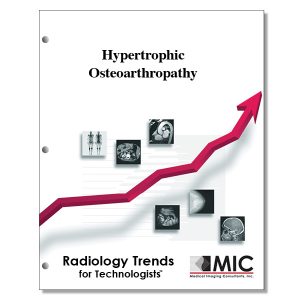

Hypertrophic Osteoarthropathy
A review of the classification, pathogenesis, clinical presentation, imaging features, and differential diagnosis of hypertrophic osteoarthropathy.
Course ID: Q00533 Category: Radiology Trends for Technologists Modalities: CT, MRI, Radiography2.0 |
Satisfaction Guarantee |
$24.00
- Targeted CE
- Outline
- Objectives
Targeted CE per ARRT’s Discipline, Category, and Subcategory classification for enrollments starting after March 18, 2024:
Computed Tomography: 2.00
Procedures: 2.00
Head, Spine, and Musculoskeletal: 2.00
Magnetic Resonance Imaging: 2.00
Procedures: 2.00
Musculoskeletal: 2.00
Nuclear Medicine Technology: 2.00
Procedures: 2.00
Other Imaging Procedures: 2.00
Radiography: 2.00
Procedures: 2.00
Extremity Procedures: 2.00
Registered Radiologist Assistant: 2.00
Procedures: 2.00
Musculoskeletal and Endocrine Sections: 2.00
Outline
- Introduction
- Classification and Nomenclature of HOA
- Pathogenesis and Etiology of HOA
- Primary HOA
- Secondary HOA
- Clinical Presentation of HOA
- Primary HOA
- Secondary HOA
- Imaging Features of HOA
- Radiography and CT
- MR Imaging
- Bone Scintigraphy
- Positron Emission Tomography
- Differential Diagnosis of HOA
- Thyroid Acropachy
- Variconazole-induced Periostitis
- Venous Stasis or Insufficiency
- Leukemia and Lymphoma
- Hypervitaminosis A
- Progressive Diaphyseal Dysplasia
- Prognosis and Treatment of HOA
- Primary HOA
- Secondary HOA
- Conclusion
Objectives
Upon completion of this course, students will:
- list the clinical features of hypertrophic osteoarthropathy
- state one of the oldest clinical signs of hypertrophic osteoarthropathy
- list the synonyms for clubbing
- indicate when hypertrophic osteoarthropathy was distinguished from acromegaly
- identify the male to female ratio of hypertrophic osteoarthropathy
- list other names for primary hypertrophic osteoarthropathy
- compare the occurrence of secondary hypertrophic osteoarthropathy to primary hypertrophic osteoarthropathy
- state the number of models currently in existence that help explain the pathogenesis associated with hypertrophic osteoarthropathy
- correlate the relationship of lung functions to secondary hypertrophic osteoarthropathy
- explain the histologic contributors to secondary hypertrophic osteoarthropathy
- state the most common cause of hypertrophic osteoarthropathy
- recall the incidence of hypertrophic osteoarthropathy in lung cancer patients
- name the clinical symptom seen in the majority of hypertrophic osteoarthropathy cases
- identify the methods to diagnose clubbing
- state the digital index necessary to determine clubbing
- list the subtypes of pachydermoperiostosis associated with primary hypertrophic osteoarthropathy
- recall the most common subtype of primary hypertrophic osteoarthropathy
- select the most advanced stage of skin hypertrophy
- choose the imaging modality used first to evaluate pain associated with hypertrophic osteoarthropathy
- list soft-tissue radiographic findings associated with hypertrophic osteoarthropathy
- state where periostosis normally manifests
- select the bones most commonly affected by periostosis
- list the multiple periosteal reactions in bone
- state the signal intensity associated with periosteal reaction as seen on MR T2-weighted images
- choose the findings at MR imaging of extremities that can be indistinguishable
- identify the imaging modality in which a tram line or double stripe sign can be seen
- state the role bone scintigraphy plays in hypertrophic osteoarthropathy
- explain how thyroid acropachy usually arises
- list the metacarpals affected by thyroid acropachy
- state symptoms experienced by patients with Voriconazole-induced periostitis
- list the appearance of periosteal reaction in patients with Voriconazole-induced periostitis
- know the imaging modality that can definitively show any associated marrow and soft-tissue abnormality involved by tumor
- state the origin of Hypervitaminosis A
- select the type of bones affected by Hypervitaminosis A
- describe progressive diaphyseal dysplasia
- list the comorbidities associated with primary hypertrophic osteoarthropathy
- recall how primary hypertrophic osteoarthropathy is usually treated
- state the prevalence of malignancy in patients with secondary hypertrophic osteoarthropathy
- list the surgical options for treating the underlying cause of secondary hypertrophic osteoarthropathy
- state causes of multi-focal periostitis
